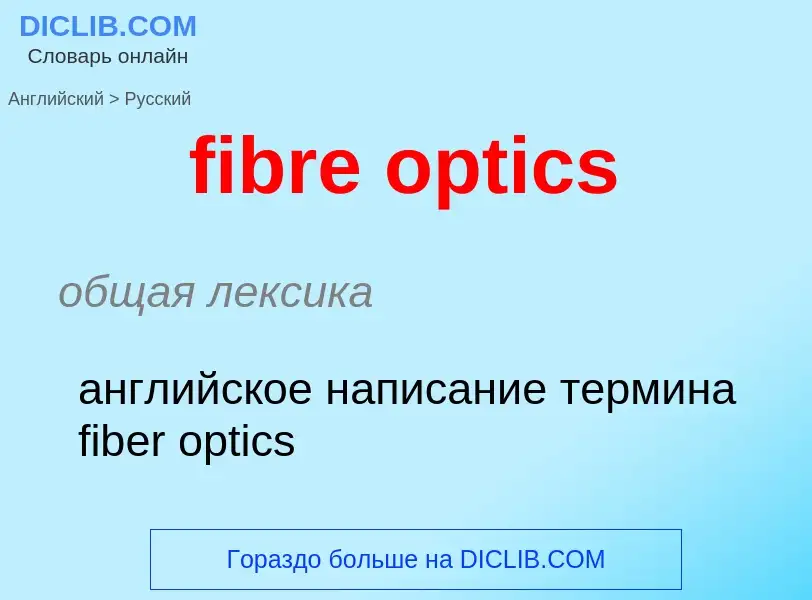Translation and analysis of words by ChatGPT artificial intelligence
On this page you can get a detailed analysis of a word or phrase, produced by the best artificial intelligence technology to date:
- how the word is used
- frequency of use
- it is used more often in oral or written speech
- word translation options
- usage examples (several phrases with translation)
- etymology
fibre optics - translation to English
общая лексика
английское написание термина fiber optics
волоконная оптика
[faibə(r)'ɔptik]
прилагательное
общая лексика
волоконно-оптический
стекловолоконный
общая лексика
волокнооптический
волоконный
Definition
Wikipedia

An optical fiber, or optical fibre in Commonwealth English, is a flexible, transparent fiber made by drawing glass (silica) or plastic to a diameter slightly thicker than that of a human hair. Optical fibers are used most often as a means to transmit light between the two ends of the fiber and find wide usage in fiber-optic communications, where they permit transmission over longer distances and at higher bandwidths (data transfer rates) than electrical cables. Fibers are used instead of metal wires because signals travel along them with less loss; in addition, fibers are immune to electromagnetic interference, a problem from which metal wires suffer. Fibers are also used for illumination and imaging, and are often wrapped in bundles so they may be used to carry light into, or images out of confined spaces, as in the case of a fiberscope. Specially designed fibers are also used for a variety of other applications, some of them being fiber optic sensors and fiber lasers.
Optical fibers typically include a core surrounded by a transparent cladding material with a lower index of refraction. Light is kept in the core by the phenomenon of total internal reflection which causes the fiber to act as a waveguide. Fibers that support many propagation paths or transverse modes are called multi-mode fibers, while those that support a single mode are called single-mode fibers (SMF). Multi-mode fibers generally have a wider core diameter and are used for short-distance communication links and for applications where high power must be transmitted. Single-mode fibers are used for most communication links longer than 1,000 meters (3,300 ft).
Being able to join optical fibers with low loss is important in fiber optic communication. This is more complex than joining electrical wire or cable and involves careful cleaving of the fibers, precise alignment of the fiber cores, and the coupling of these aligned cores. For applications that demand a permanent connection a fusion splice is common. In this technique, an electric arc is used to melt the ends of the fibers together. Another common technique is a mechanical splice, where the ends of the fibers are held in contact by mechanical force. Temporary or semi-permanent connections are made by means of specialized optical fiber connectors.
The field of applied science and engineering concerned with the design and application of optical fibers is known as fiber optics. The term was coined by Indian-American physicist Narinder Singh Kapany.



![A [[TOSLINK]] fiber optic audio cable with red light shone in one end A [[TOSLINK]] fiber optic audio cable with red light shone in one end](https://commons.wikimedia.org/wiki/Special:FilePath/Fiber optic illuminated.jpg?width=200)
![A [[frisbee]] illuminated by fiber optics A [[frisbee]] illuminated by fiber optics](https://commons.wikimedia.org/wiki/Special:FilePath/Flashflight red.jpg?width=200)
![acrylic]] rod, illustrating the total internal reflection of light in a multi-mode optical fiber. acrylic]] rod, illustrating the total internal reflection of light in a multi-mode optical fiber.](https://commons.wikimedia.org/wiki/Special:FilePath/Laser in fibre.jpg?width=200)


![multi-mode fibers]]. multi-mode fibers]].](https://commons.wikimedia.org/wiki/Special:FilePath/Optical-fibre-junction-box.jpg?width=200)

![An [[optical fiber cable]] An [[optical fiber cable]]](https://commons.wikimedia.org/wiki/Special:FilePath/Optical fiber cable.jpg?width=200)

![ST connectors]] on [[multi-mode fiber]] ST connectors]] on [[multi-mode fiber]]](https://commons.wikimedia.org/wiki/Special:FilePath/ST-optical-fiber-connector-hdr-0a.jpg?width=200)


